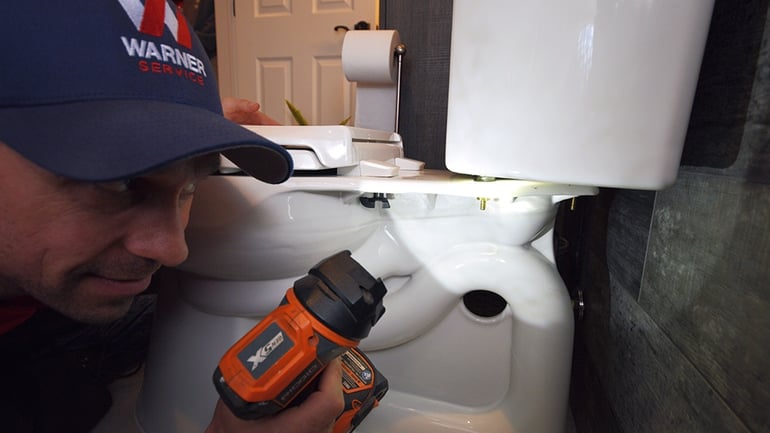 A few surprising toilet plumbing problems can arise -- literally. Has the water ever slowly risen in the bowl, sending you into a panic? Have you hit the handle but nothing happens?
A few surprising toilet plumbing problems can arise -- literally. Has the water ever slowly risen in the bowl, sending you into a panic? Have you hit the handle but nothing happens?
Warner Service offers insight on diagnosing plumbing problems and how to solve them:
- Blocked or clogged toilet. This is one of the most common plumbing problems. To fix it, grab a plunger or drain snake to loosen any debris. If the problem persists, call a local plumber.
- Cold shower due to simultaneously flushing the toilet. The solution is to reduce how quickly the toilet uses water. This is especially helpful with older plumbing anatomy.
Close the supply valve slightly; purchase a low-flow toilet; or place a jug of gravel, pebbles, or sand in the toilet tank. You may have a noisy toilet that takes longer to fill, but the shower won’t be cold anymore. - Gathered water. If water is on the floor around the toilet, fix it right away. (Moisture damages the subfloor.) Check the tightness of the tank bolts, fill valve/ballcock, mounting nut, and supply tube coupling nut. If any of those plumbing components are loose, replace the washers.
This plumbing problem could also be due to an unsealed wax ring or cracked toilet base. If the toilet leaks constantly, replace the base. If leaking occurs only during or after a flush, replace the wax ring.
If you live in a humid climate and water is dripping from the tank’s side, it’s condensation. Use proper ventilation or buy a toilet liner kit, a foam panel placed inside the tank. - Overflowing toilet. Whether you hit the handle one too many times or it's too cold outside, the toilet has a mechanical problem. Wrap a towel around the base, and then turn off the toilet’s water supply line. (To do this, locate the line’s valve near the bowl's bottom.) Turn it counterclockwise to stop water flow from the toilet.
If this doesn't fix the toilet overflow, remove the tank cover. Lift the float cup high enough so water stops running. Turn the water heater valve off until the water flow in your home stops completely.
Then, use a small cup to remove any excess water at the brim of the bowl. Wipe up the excess water off the floor. - “Phantom flushes.” If you hear a noisy toilet spontaneously refill like someone flushed it, a very slow leak is happening from the tank to the bowl. It’s caused by a bad flapper or flapper seat. Drain the tank and bowl then check and clean the flapper seat or replace a worn or damaged flapper.
- Rising water. Don’t flush again. To fix this plumbing problem, cut the toilet’s water supply by turning off its shut-off valve. (If you’re not sure where that component is, check out Toilet Anatomy 101: Your Toilet Parts and How They Work.)
Next, grab a plunger or drain snake. If that doesn’t solve the plumbing problem, call a local plumber. - Running water. This is one of the most common problems in homes with older plumbing anatomy. It’s caused by a dirty or old flapper or flush valve, a tangled float chain, or a misaligned float. Because a running toilet wastes gallons of water each day, call a local plumber to find a permanent solution.
- Stubborn handle. If the toilet handle won’t budge, Lowe’s suggests removing the tank cover. After that, clean the mounting nut for smooth operation. If a buildup of lime is around the mounting nut, clean it with a brush dipped in vinegar.
- Unpleasant odor. The only thing worse than a noisy toilet is a smelly one. If the toilet smells like sewage, it’s likely that someone forgot to flush. If upon further inspection that’s not the case, you have a serious problem on your hands.
This plumbing problem is a result of a damaged fitting in the drain pipes, a defective wax ring, or a lack of water in the bowl. Solutions range from simple maintenance to a full-scale toilet replacement. Call the pros to discuss which option is best for you. - Weak flush. A bowl that empties slowly is the result of clogged holes underneath the bowl’s rim. Master plumber Ed Del Grande suggests using a curved piece of wire, like coat-hanger wire, to poke into each flush hole to clear out and loosen any debris. Be careful to avoid scratching the bowl. If this doesn’t work, call a plumber.
No more cold showers and toilet overflows after following Warner Service’s quick solutions. If you want to learn more about your entire bathroom, download our Bathroom Maintenance Checklist:


